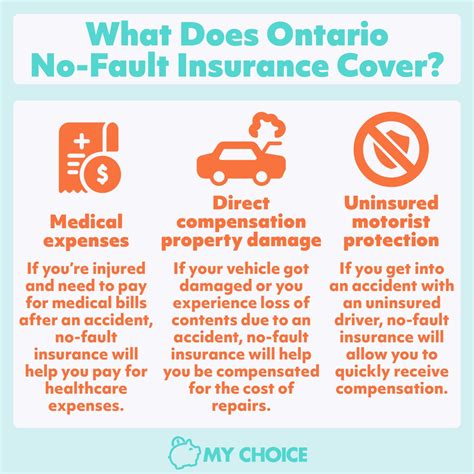What Is Nofault Insurance

In the intricate world of insurance, the concept of Nofault Insurance is a unique and innovative approach to protecting individuals and businesses from potential financial losses. Unlike traditional insurance policies that often involve determining fault and liability, Nofault Insurance operates on a different principle, offering a fresh perspective on risk management and financial security.
This article aims to delve into the intricacies of Nofault Insurance, exploring its definition, how it works, and its potential benefits and limitations. By understanding this alternative insurance model, we can gain valuable insights into the evolving landscape of risk coverage and its implications for individuals and organizations.
Understanding Nofault Insurance

Nofault Insurance, often referred to as no-fault coverage or no-fault insurance systems, is a type of insurance policy designed to provide financial protection to policyholders without the need to establish fault or liability in the event of an accident or incident.
This insurance concept finds its roots in the desire to streamline the claims process and offer a faster, more efficient way to receive compensation for losses. By removing the need for extensive investigations and legal proceedings, Nofault Insurance aims to provide a swift and straightforward solution for policyholders seeking financial relief.
Key Characteristics of Nofault Insurance
Nofault Insurance policies typically exhibit several key characteristics that differentiate them from traditional insurance plans.
- Presumption of Fault: In Nofault Insurance, there is a presumption that accidents are random events, and determining fault is not a prerequisite for claiming benefits. This approach simplifies the claims process and reduces the need for extensive investigations.
- Swift Claims Settlement: One of the primary advantages of Nofault Insurance is the rapid settlement of claims. Policyholders can receive compensation for their losses within a relatively short timeframe, ensuring they can quickly recover from the financial impact of an accident.
- Broad Coverage: These policies often offer comprehensive coverage, including medical expenses, lost wages, and property damage. This broad scope ensures that policyholders are protected from a wide range of potential losses.
- Reduced Litigation: By eliminating the need to assign fault, Nofault Insurance significantly reduces the likelihood of legal disputes and lengthy court proceedings. This not only benefits policyholders but also contributes to a more efficient legal system.
- Mandatory in Some Jurisdictions: In certain regions, Nofault Insurance is a mandatory requirement for vehicle owners. This mandatory coverage ensures that all drivers have a basic level of financial protection in the event of an accident.
How Nofault Insurance Works
The operational mechanism of Nofault Insurance involves a straightforward process, focusing on swift compensation without the complexities of fault determination.
- Policy Purchase: Individuals or businesses purchase Nofault Insurance policies from insurance providers. These policies can cover a range of scenarios, including auto accidents, personal injuries, or property damage.
- Accident or Incident: In the event of an accident or incident covered by the policy, the policyholder contacts their insurance provider to initiate a claim.
- Claim Process: The insurance provider assesses the claim based on the policy's terms and conditions. Unlike traditional insurance, the focus is not on establishing fault but on verifying the legitimacy of the claim and the extent of the losses.
- Compensation: Once the claim is approved, the insurance provider provides compensation to the policyholder, covering the specified losses. This compensation can include medical expenses, rehabilitation costs, lost income, and other related expenses.
Benefits of Nofault Insurance

Nofault Insurance offers a range of advantages that make it an appealing option for individuals and businesses seeking financial protection.
Simplified Claims Process
One of the most significant benefits of Nofault Insurance is the simplified claims process. Policyholders do not need to engage in lengthy investigations or legal battles to prove fault. This streamlined process reduces the stress and complexity often associated with traditional insurance claims.
Swift Compensation
Nofault Insurance is designed to provide rapid compensation to policyholders. The absence of fault determination accelerates the claims settlement process, ensuring that individuals can quickly recover from financial losses resulting from accidents or incidents.
Reduced Legal Disputes
By removing the need to assign fault, Nofault Insurance significantly reduces the likelihood of legal disputes and court cases. This not only benefits policyholders by avoiding costly and time-consuming legal battles but also contributes to a more efficient and less congested legal system.
Broad Coverage
Nofault Insurance policies often offer comprehensive coverage, ensuring that policyholders are protected from a wide range of potential losses. This broad coverage provides peace of mind, knowing that financial protection is in place for various unforeseen events.
Cost Efficiency
The simplified claims process and reduced legal involvement associated with Nofault Insurance can lead to cost savings for both policyholders and insurance providers. These cost savings can translate into more affordable insurance premiums, making financial protection accessible to a wider range of individuals and businesses.
Limitations and Considerations
While Nofault Insurance offers numerous benefits, it is essential to consider certain limitations and potential drawbacks.
Limited Coverage in Some Cases
While Nofault Insurance provides broad coverage, there may be situations where the coverage is limited or excluded. Policyholders should carefully review their policies to understand the specific terms and conditions, ensuring they are aware of any potential gaps in coverage.
Increased Premiums
In some cases, Nofault Insurance policies may result in higher insurance premiums compared to traditional insurance plans. This is because insurance providers may need to account for the increased risk associated with the absence of fault determination.
Potential for Abuse
One of the criticisms of Nofault Insurance is the potential for abuse. Without the need to establish fault, there is a risk that some individuals may exploit the system, making fraudulent claims or exaggerating their losses. Insurance providers employ various measures to mitigate this risk, but it remains a potential concern.
Limited Application
Nofault Insurance is primarily applicable to specific types of incidents, such as auto accidents or personal injuries. For other types of risks, such as property damage caused by natural disasters, traditional insurance policies may be more suitable.
Regulatory and Legal Considerations
The implementation and regulation of Nofault Insurance vary across jurisdictions. Policyholders should be aware of the specific laws and regulations governing Nofault Insurance in their region to ensure compliance and understand their rights and obligations.
Real-World Applications and Case Studies
Nofault Insurance has found practical applications in various industries and scenarios, showcasing its effectiveness and impact.
Automobile Insurance
One of the most common applications of Nofault Insurance is in the realm of automobile insurance. Many states in the United States have adopted no-fault auto insurance systems, ensuring that drivers are financially protected in the event of accidents. This approach has streamlined the claims process and reduced the burden on the legal system.
Personal Injury Protection
Nofault Insurance policies are also used to provide personal injury protection, covering medical expenses and lost wages for individuals who sustain injuries due to accidents or incidents. This type of coverage ensures that individuals can access the necessary medical care and financial support during their recovery.
Workers’ Compensation
In the context of workers’ compensation, Nofault Insurance plays a crucial role in providing financial protection to employees who suffer work-related injuries or illnesses. By removing the need to establish fault, workers can quickly receive compensation for their medical expenses and lost wages, ensuring they can focus on their recovery without financial strain.
Future Implications and Innovations

As the insurance industry continues to evolve, Nofault Insurance is likely to undergo further developments and adaptations to meet the changing needs of policyholders.
Technological Advancements
The integration of technology, such as artificial intelligence and machine learning, can enhance the efficiency and accuracy of Nofault Insurance claims processes. These technologies can streamline data analysis, reduce human error, and improve overall claim management.
Data-Driven Underwriting
With the availability of vast amounts of data, insurance providers can employ data-driven underwriting techniques to assess risk more accurately. This approach can lead to more tailored and cost-effective Nofault Insurance policies, ensuring that policyholders receive coverage that aligns with their specific needs.
Expanded Coverage Options
As the insurance industry adapts to emerging risks and changing societal needs, Nofault Insurance may expand its coverage options. This could include the development of policies that address new types of incidents, such as cyberattacks or environmental hazards.
Collaboration with Fintech
The collaboration between insurance providers and fintech companies can revolutionize the way Nofault Insurance is delivered. Fintech innovations, such as blockchain technology and smart contracts, can enhance the security, transparency, and efficiency of insurance transactions.
Conclusion
Nofault Insurance represents a unique and innovative approach to risk management and financial protection. By simplifying the claims process and removing the need for fault determination, it offers a swift and efficient solution for policyholders seeking compensation for losses. While it has its limitations and considerations, Nofault Insurance has proven to be a valuable tool in various industries, providing peace of mind and financial security to individuals and businesses alike.
As the insurance landscape continues to evolve, Nofault Insurance is poised to play a significant role in shaping the future of risk coverage. With ongoing technological advancements and industry innovations, we can expect to see further enhancements and adaptations that will benefit policyholders and drive the industry forward.
What is the difference between Nofault Insurance and traditional insurance policies?
+Nofault Insurance differs from traditional insurance policies in its approach to fault determination. Traditional insurance often requires establishing fault or liability to claim benefits, while Nofault Insurance provides coverage regardless of fault, streamlining the claims process.
Is Nofault Insurance mandatory in all jurisdictions?
+No, Nofault Insurance is not mandatory in all jurisdictions. Its implementation varies across regions, with some states or countries requiring it for specific types of insurance, such as auto insurance, while others do not.
What are the potential drawbacks of Nofault Insurance?
+Potential drawbacks of Nofault Insurance include limited coverage in certain situations, increased premiums compared to traditional insurance, and the risk of fraudulent claims. Policyholders should carefully review their policies and be aware of these considerations.
How does Nofault Insurance benefit the legal system?
+Nofault Insurance benefits the legal system by reducing the number of legal disputes and court cases related to accidents or incidents. By removing the need to assign fault, it streamlines the resolution process and contributes to a more efficient legal environment.
What innovations can we expect in Nofault Insurance in the future?
+Future innovations in Nofault Insurance may include the integration of technology for more efficient claims processing, data-driven underwriting for better risk assessment, expanded coverage options to address emerging risks, and collaboration with fintech for enhanced security and transparency.



